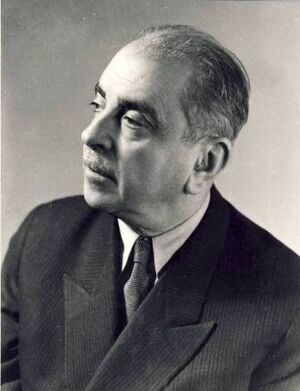Simion Stoilow facts for kids
Quick facts for kids
Simion Stoilow
|
|
|---|---|
 |
|
| Born | 14 September 1887 |
| Died | 4 April 1961 (aged 73) |
| Nationality | Romanian |
| Alma mater | University of Paris |
| Known for | Complex analysis Kerékjártó–Stoilow compactification Iversen–Stoilow surface Stoilov theorem Open and closed maps |
| Awards | Legion of Honour Order of the Star of Romania Order of the Star of the Romanian People's Republic |
| Scientific career | |
| Fields | Mathematics |
| Institutions | University of Iași University of Cernăuți Polytechnic University of Bucharest University of Bucharest Institute of Mathematics of the Romanian Academy |
| Thesis | Sur une classe de fonctions de deux variables définies par les équations linéaires aux dérivées partielles (1916) |
| Doctoral advisor | Émile Picard |
| Doctoral students | Cabiria Andreian Cazacu |
| Other notable students | Tudor Ganea Valentin Poénaru |
Simion Stoilow (born September 14, 1887 – died April 4, 1961) was a very important Romanian mathematician. He is known for starting the Romanian way of studying complex analysis, which is a special part of mathematics. He wrote over 100 books and papers during his life.
Contents
Who Was Simion Stoilow?
His Early Life and Education
Simion Stoilow was born in Bucharest, Romania, and grew up in a city called Craiova. His father, Colonel Simion Stoilow, was a brave soldier who fought in the Romanian War of Independence.
After finishing elementary school and high school, Simion went to the University of Paris in 1907. He worked very hard and earned his first university degree in 1910. Then, in 1916, he earned a Ph.D. in Mathematics. This is the highest degree you can get in a subject. His main teacher for his Ph.D. was a famous mathematician named Émile Picard.
Fighting for His Country
In 1916, Simion Stoilow returned to Romania to join the army. He fought in World War I during the Romanian Campaign. He served in different parts of the country, helping his nation during the war.
A Career in Teaching and Research
After the war, Stoilow became a professor of mathematics. He taught at the University of Iași from 1919 to 1921. Then he moved to the University of Cernăuți, where he taught from 1921 to 1939.
He was so respected that he was invited to speak at big international meetings for mathematicians. These meetings were held in Strasbourg (1920), Bologna (1928), and Oslo (1936). In 1928, France gave him a special award called the Legion of Honour.
In 1939, he moved back to Bucharest. He taught at the Polytechnic University of Bucharest and later at the University of Bucharest. He even became the leader, or rector, of the University of Bucharest from 1944 to 1946. From 1948 to 1951, he was the dean of the math and physics departments.

Serving as an Ambassador
From 1946 to 1948, Simion Stoilow served as Romania's ambassador to France. This meant he represented Romania in France. He was also part of the Romanian team at the Paris Peace Conference in 1946. This conference helped decide what would happen after World War II.
In 1947, he helped organize an art show in Paris to raise money for Romanian children. Famous artists like Constantin Brâncuși were part of it. For his important work, he received more awards from Romania, including the Order of the Star of Romania in 1946 and the Order of the Star of the Romanian People's Republic in 1948.
Leading the Math Institute
In 1936, Stoilow became a member of the Romanian Academy, which is a very important group of smart people. He became a full member in 1945. In 1949, he helped start the Institute of Mathematics of the Romanian Academy. He was the first director of this institute and led it until he passed away.
Many students learned from him at the University of Bucharest and the Institute. Some of his students became famous mathematicians themselves, like Tudor Ganea and Valentin Poénaru. In 1952, he received another high award, the Order of the Star of the Romanian People's Republic, First Class.
Simion Stoilow died in Bucharest in 1961.
What Is Simion Stoilow's Legacy?
The Institute of Mathematics of the Romanian Academy is now named after him. This shows how important he was to mathematics in Romania. Also, the Simion Stoilow Prize is given out every year by the Romanian Academy to honor his work and encourage new mathematicians.
His Important Works
Simion Stoilow wrote several important books and papers that are still studied today. Two of his most famous works are:
- Simion Stoïlow, "Leçons sur les principes topologiques de la théorie des fonctions analytiques" (Lessons on the Topological Principles of the Theory of Analytic Functions), published in Paris in 1956.
- Simion Stoïlow, "Œuvre mathématique" (Mathematical Works), published in Bucharest in 1964.

